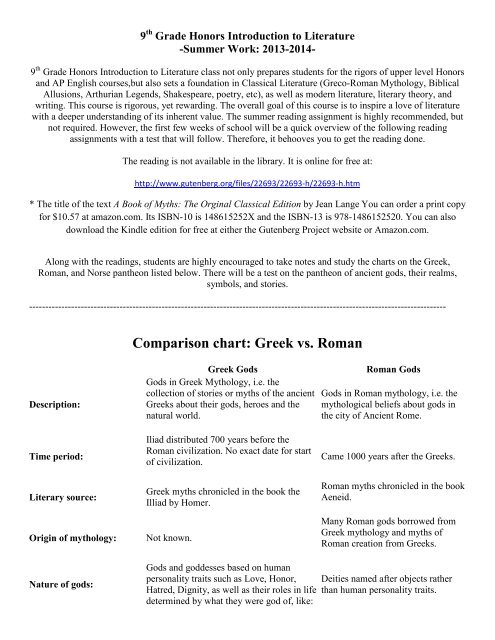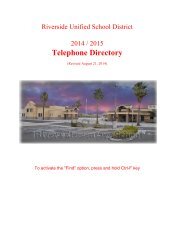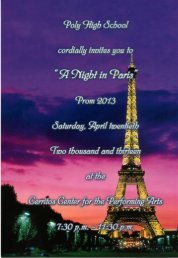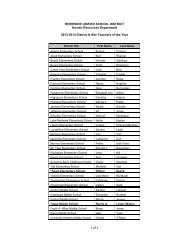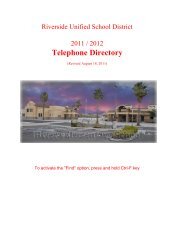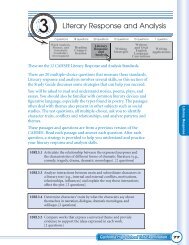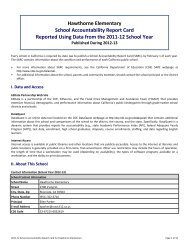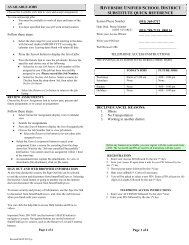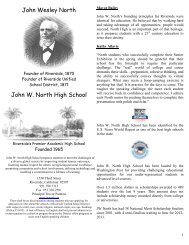Comparison chart: Greek vs. Roman
Comparison chart: Greek vs. Roman
Comparison chart: Greek vs. Roman
Create successful ePaper yourself
Turn your PDF publications into a flip-book with our unique Google optimized e-Paper software.
more individualistic, the deeds of an individual are more influential than that of the group. <strong>Roman</strong> mythology ismuch less individualistic.<strong>Greek</strong> Gods and their <strong>Roman</strong> Counterparts<strong>Greek</strong> God(English name)<strong>Roman</strong>CounterpartAphrodite Venus Goddess of LoveApollo Phoebus Apollo God of LightAres Mars God of warArtemisDianaAthena Minerva Goddess of wisdomDemeter Ceres Goddess of grain/cropsDionysus Bacchus God of wineEros Cupid God of loveHades Pluto God of underworldDomainVirgin goddess of the hunt, wilderness, wild animals, childbirth andplague. In later times she became associated with the moon.Hecate Trivia Goddess of witchcraft, crossroads, and justiceHelios Sol The sun GodHephaestus Vulcan God of fireHera Juno Queen of the GodsHermes Mercury Messenger of the GodsNike Victoria Goddess of victoryPan Faunus God of woods and pasturesPoseidon Neptune God of the seaZeus Jupiter King of GodsAfterlifeIn <strong>Greek</strong> mythology, the afterlife does not hold much importance. In fact, gods and mortals are regularlysnatched from the afterlife and brought in to the present showing no concern for the afterlife. It is much moreconcerned with the physical life on earth as opposed to the afterlife. Mortals are remembered and rewarded fortheir good deeds on earth.
Freya is considered to be the goddess of Love and Beauty, but is also a warrior goddessand one of great wisdom and magick. She and her twin brother Freyr are of a different"race" of gods known as the Vanir. Many of the tribes venerated her higher than theAesir, calling her "the Frowe" or "The Lady." She is known as Queen of the Valkyries,choosers of those slain in battle to bear them to Valhalla (the Norse heaven). She,therefore, is a psychopomp like Odhinn and it is said that she gets the "first pick" of thebattle slain. She wears the sacred necklace Brisingamen, which she paid for by spendingthe night with the dwarves who wrought it from the bowels of the earth. The cat is hersacred symbol. There seems to be some confusion between herself and Fricka, Odin'swife, as they share similar functions; but Fricka seems to be strictly of the Aesir, while Freya is of the Vanicrace. The day Friday (Frejyasdaeg) was named for her (some claim it was for Fricka).Freyr (Fro Ingwe) is Freya's twin brother. He is the horned God of fertility, and hassome similarities to the Celtic Cernunnos or Herne, although he is NOT the same being.He is known as King of the Alfs (elves). Both the Swedish and the English are said to bedescendents of his. The Boar is his sacred symbol, which is both associated with war andwith fertility. His golden boar, "Gullenbursti", is supposed to represent the daybreak. Heis also considered to be the God of Success, and is wedded to Gerda, the Jotun, forwhom he had to yield up his mighty sword. At Ragnarok, he is said to fight with thehorn of an elk (much more suited to his nature rather than a sword.)Tyr: (or Tiw, Ziw) is the ancient god of War and the Lawgiver of the gods. He sacrifices his hand so that theevil Fenris wolf may be bound. At one time he was the leader of the Norse Pantheon, but was supplanted byOdin much later. There is nothing to indicate how this occurred; one assumes that he simply "stepped back" andlet Odin assume the position of leadership. Tyr is excellent in all manners of Justice, fairplay, and Right Action.Loki, the Trickster, challenges the structure and order of the Gods, but is necessary inbringing about needed change. He is also known as the god of Fire. Neither an Aesir or aVanir, he is of the race of Ettins (Elementals) and thus possesses some daemonicqualities. He is both a helper and a foe of the Aesir; he gets them out of predicaments,but spawns the worst monsters ever seen on the face of the Earth: the Fenris Wolf andJormurgandr, the Midgard Wyrm. His other children include the goddess Hel (Hella, Holle), and Sleipnir,Odin's 8-legged horse; these beings are at least benign, if not somewhat terrifying to behold.Heimdall is the handsome gold-toothed guardian of Bifrost, therainbow bridge leading to Asgard, the home of the Gods. The rainbowbridge seems to be a common symbol in many religious traditions otherthan Norse Heathenism. In the Vedic tradition, it represents theAntakaranha of humanity (connection between the body and the soul).Other traditions see it as a message from the Gods, or a Bridge betweenthe Gods and Mankind. This would tend to indicate that theNorse/Germanic people were aware of the presence of an
overshadowing Soul for each individual, as well as a group or tribal intelligence. It is Heimdall who is to soundthe signal horn to the Aesir that Ragnarok, the great destruction (or transformation?) is beginning.Skadi is the Goddess of Winter and of the Hunt. She is married to Njord, the gloomySea God, noted for his beautiful bare feet (which is how Skadi came to choose him forher mate.) Supposedly the bare foot is an ancient Norse symbol of fertility. Themarriage wasn't too happy, though, because she really wanted Baldur for her husband.She is the goddess of Justice, Vengeance, and Righteous Anger, and is the deity whodelivers the sentence upon Loki to be bound underground with a serpent drippingpoison upon his face in payment for his crimes. Skadi's character is represented in twoof Hans Christian Anderson's tales: "The Snow Queen" and "The Ice Princess."Frigga (Frigg, Fricka), Odin's wife, was considered to be the Mother of all; and protectoress of children. Shespins the sacred Distaff of life, and is said to know the future, although she will not speak of it. Some believethat Friday was named for her instead of Freya (see above), and there is considerable confusion as to "who doeswhat" among the two.The Norns (Urd, Verdande, and Skuld), are the Norse equivalent of the greek Fates. It is they who determinethe orlogs (destinies) of the Gods and of Man, and who maintain the World Tree, Yggdrasil.The goddess of the dead and the afterlife was Hel (Holle, Hulda), and was portrayed by the Vikings as beinghalf-dead, half alive herself. The Vikings viewed her with considerable trepidation. The Dutch, Gallic, andGerman barbarians viewed her with some beneficence, more of a gentler form of death and transformation. Sheis seen by them as Mother Holle; a being of pure Nature, being helpful in times of need, but vengeful uponthose who cross her or transgress natural law.Odin's son, Baldur, the god of Love and Light, is sacrificed at Midsummer by the dart of the mistletoe, and isreborn at Jul (Yule). Supposedly his return will not occur until after the onslaught of the Ragnarok, which I seeas a cleansing and enlightenment more than wanton, purposeless destruction. Baldur's blind brother Hodur washis slayer, whose hand was guided by the crafty Loki. He is married to the goddess of Joy, Nanna.Other Gods and Goddesses include Sif (Sifa), the Harvest Goddess; Forseti, the god of Law and Justice; Bragi,the bard of the Gods and muse of Poetry; Weiland (Weyland), the Smith of the Gods, Idunna, the goddess ofYouth and Beauty; Vidar and Vali, the sons of Odin who will survive Ragnarok; Magni and Modi, the sonsof Thor; Eostre, the goddess of Spring and of fertility, Hoenir, the messenger of the Aesir; Sunna and Mani,the Sun and Moon; Ullr, the God of the Hunt; and Nerthus, Goddess of the Sea and of Rivers.*http://wizardrealm.com/norse/gods.htmlGood Luck and Happy Reading,Mrs. Murray (cmurray@rusd.k12.ca.us)Mrs. A. Wilson (awilson@rusd.k12.ca.us)


